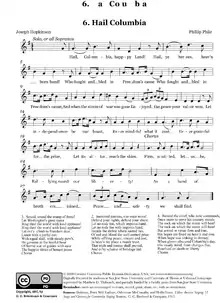Hail, Columbia
"Hail, Columbia" is an American patriotic song that is the ceremonial entrance march of the Vice President of the United States. It was considered one of the unofficial national anthems of the United States until 1931, when "The Star-Spangled Banner" was named as the official national anthem. Columbia is the name for the national personification of the United States which originated during the 18th century. "Hail, Columbia" is considered an unofficial anthem of the United States.
 Cover of an 1861 sheet music for "Hail, Columbia" | |
Personal anthem of the Unofficial anthem of the | |
| Also known as | "The President's March" |
|---|---|
| Lyrics | Joseph Hopkinson, 1798 |
| Music | Philip Phile, 1789 |
| Adopted | 1789 |
| Relinquished | March 3, 1931 |
| Succeeded by | "The Star-Spangled Banner" (as national anthem) |
| Audio sample | |
"Hail, Columbia", preceded by four ruffles and flourishes (as would be played for the U.S. vice president), performed instrumentally by the United States Navy Band's ceremonial band
| |

History
The music was composed by Philip Phile in 1789 for the first inauguration of George Washington and titled "The President's March". It became the song "Hail, Columbia" when arranged with lyrics by Joseph Hopkinson in 1798. The song was used in the United States as a de facto national anthem for most of the 19th century,[1] but it lost popularity after World War I when it was replaced by "The Star-Spangled Banner" in 1931.
It was the personal anthem for the president, until it was replaced by the song "Hail to the Chief",[2] and it is now the official vice president's personal anthem.[3] The song is always preceded by four ruffles and flourishes when introducing the vice president. It has also been used as a slow march during military ceremonies, often while the band counter-marches.
Lyrics
Hail Columbia, happy land!
Hail, ye heroes, heav'n-born band,
𝄆 Who fought and bled in freedom's cause, 𝄇
And when the storm of war was gone
Enjoy'd the peace your valor won.
Let independence be our boast,
Ever mindful what it cost;
Ever grateful for the prize,
Let its altar reach the skies.
Chorus
Firm, united let us be,
Rallying round our liberty,
As a band of brothers joined,
Peace and safety we shall find.
Immortal patriots, rise once more,
Defend your rights, defend your shore!
𝄆 Let no rude foe, with impious hand, 𝄇
Invade the shrine where sacred lies
Of toil and blood, the well-earned prize,
While off'ring peace, sincere and just,
In Heaven's we place a manly trust,
That truth and justice will prevail,
And every scheme of bondage fail.
Chorus
Firm, united let us be,
Rallying round our liberty,
As a band of brothers joined,
Peace and safety we shall find.
Sound, sound the trump of fame,
Let Washington's great name
𝄆 Ring through the world with loud applause, 𝄇
Let ev'ry clime to freedom dear,
Listen with a joyful ear,
With equal skill, with God-like pow'r
He governs in the fearful hour
Of horrid war, or guides with ease
The happier times of honest peace.
Chorus
Firm, united let us be,
Rallying round our liberty,
As a band of brothers joined,
Peace and safety we shall find.
Behold the chief who now commands,
Once more to serve his country stands.
𝄆 The rock on which the storm will break, 𝄇
But armed in virtue, firm, and true,
His hopes are fixed on Heav'n and you.
When hope was sinking in dismay,
When glooms obscured Columbia's day,
His steady mind, from changes free,
Resolved on death or liberty.
Chorus
Firm, united let us be,
Rallying round our liberty,
As a band of brothers joined,
Peace and safety we shall find.
References
- Collins, Ace. Songs Sung, Red, White, and Blue: The Stories Behind America's Best-Loved Patriotic Songs. HarperResource, 2003, pp. 98–105.
- Collins, Ace. Songs Sung, Red, White, and Blue: The Stories Behind America's Best-Loved Patriotic Songs. HarperResource, 2003, p. 105.
- "Ruffles and Flourishes". Virginia Tech Multimedia Music Dictionary. Department of Music, Virginia Polytechnic Institute and State University. Retrieved 4 August 2013.
Citing:- "Table 2-1. Ceremony and Parade Requirements". Army Regulation 600–25: Personnel—General: Salutes, Honors, and Visits of Courtesy (PDF). Washington, D.C.: Headquarters, Department of the Army. 1 September 1983. p. 5. Retrieved 17 June 2017.
- Kendall, David (ed.). "United States (to 1931)". nationalanthems.info. Retrieved 4 August 2013.
- "Search for 'Hail, Columbia'". The Lester S. Levy Sheet Music Collection, Johns Hopkins University. Archived from the original on 4 March 2016. Retrieved 4 August 2013.
- "Hail Columbia [article]". Performing Arts Encyclopedia. Library of Congress. 13 July 2013. Retrieved 4 August 2013.
Further reading
- Army Regulation 600–25: Personnel—General: Salutes, Honors, and Visits of Courtesy (PDF). Washington, D.C.: Headquarters, Department of the Army. 24 September 2004. Table 2-1, pp. 11–12. Retrieved 4 August 2013. The current version of the Army's protocol.
External links
| Wikisource has original text related to this article: |